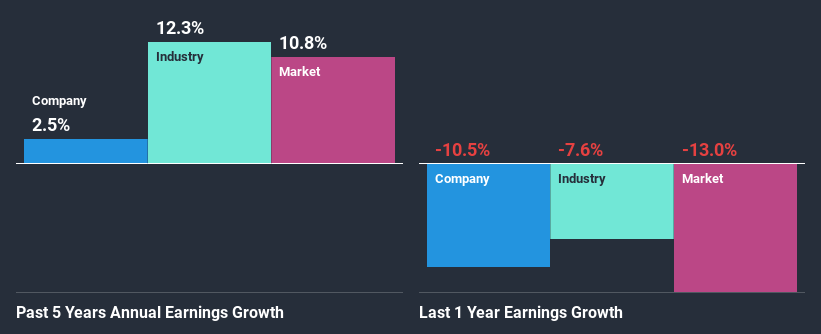- United Kingdom
- /
- Insurance
- /
- LSE:DLG
Is Direct Line Insurance Group plc's (LON:DLG) Recent Stock Performance Influenced By Its Fundamentals In Any Way?

Most readers would already be aware that Direct Line Insurance Group's (LON:DLG) stock increased significantly by 9.9% over the past month. As most would know, fundamentals are what usually guide market price movements over the long-term, so we decided to look at the company's key financial indicators today to determine if they have any role to play in the recent price movement. Particularly, we will be paying attention to Direct Line Insurance Group's ROE today.
ROE or return on equity is a useful tool to assess how effectively a company can generate returns on the investment it received from its shareholders. In other words, it is a profitability ratio which measures the rate of return on the capital provided by the company's shareholders.
See our latest analysis for Direct Line Insurance Group
How To Calculate Return On Equity?
Return on equity can be calculated by using the formula:
Return on Equity = Net Profit (from continuing operations) ÷ Shareholders' Equity
So, based on the above formula, the ROE for Direct Line Insurance Group is:
13% = UK£401m ÷ UK£3.1b (Based on the trailing twelve months to June 2020).
The 'return' refers to a company's earnings over the last year. One way to conceptualize this is that for each £1 of shareholders' capital it has, the company made £0.13 in profit.
What Has ROE Got To Do With Earnings Growth?
So far, we've learned that ROE is a measure of a company's profitability. We now need to evaluate how much profit the company reinvests or "retains" for future growth which then gives us an idea about the growth potential of the company. Assuming everything else remains unchanged, the higher the ROE and profit retention, the higher the growth rate of a company compared to companies that don't necessarily bear these characteristics.
A Side By Side comparison of Direct Line Insurance Group's Earnings Growth And 13% ROE
To start with, Direct Line Insurance Group's ROE looks acceptable. Further, the company's ROE is similar to the industry average of 12%. Despite the moderate return on equity, Direct Line Insurance Group has posted a net income growth of 2.5% over the past five years. So, there could be some other factors at play that could be impacting the company's growth. For instance, the company pays out a huge portion of its earnings as dividends, or is faced with competitive pressures.
As a next step, we compared Direct Line Insurance Group's net income growth with the industry and were disappointed to see that the company's growth is lower than the industry average growth of 12% in the same period.

Earnings growth is a huge factor in stock valuation. What investors need to determine next is if the expected earnings growth, or the lack of it, is already built into the share price. Doing so will help them establish if the stock's future looks promising or ominous. Is DLG fairly valued? This infographic on the company's intrinsic value has everything you need to know.
Is Direct Line Insurance Group Using Its Retained Earnings Effectively?
The high three-year median payout ratio of 65% (that is, the company retains only 35% of its income) over the past three years for Direct Line Insurance Group suggests that the company's earnings growth was lower as a result of paying out a majority of its earnings.
Moreover, Direct Line Insurance Group has been paying dividends for eight years, which is a considerable amount of time, suggesting that management must have perceived that the shareholders prefer dividends over earnings growth. Looking at the current analyst consensus data, we can see that the company's future payout ratio is expected to rise to 83% over the next three years. Regardless, the future ROE for Direct Line Insurance Group is speculated to rise to 19% despite the anticipated increase in the payout ratio. There could probably be other factors that could be driving the future growth in the ROE.
Conclusion
In total, it does look like Direct Line Insurance Group has some positive aspects to its business. Yet, the low earnings growth is a bit concerning, especially given that the company has a high rate of return. Investors could have benefitted from the high ROE, had the company been reinvesting more of its earnings. As discussed earlier, the company is retaining a small portion of its profits. Having said that, looking at the current analyst estimates, we found that the company's earnings are expected to gain momentum. To know more about the company's future earnings growth forecasts take a look at this free report on analyst forecasts for the company to find out more.
If you’re looking to trade Direct Line Insurance Group, open an account with the lowest-cost* platform trusted by professionals, Interactive Brokers. Their clients from over 200 countries and territories trade stocks, options, futures, forex, bonds and funds worldwide from a single integrated account. Promoted
New: Manage All Your Stock Portfolios in One Place
We've created the ultimate portfolio companion for stock investors, and it's free.
• Connect an unlimited number of Portfolios and see your total in one currency
• Be alerted to new Warning Signs or Risks via email or mobile
• Track the Fair Value of your stocks
This article by Simply Wall St is general in nature. It does not constitute a recommendation to buy or sell any stock, and does not take account of your objectives, or your financial situation. We aim to bring you long-term focused analysis driven by fundamental data. Note that our analysis may not factor in the latest price-sensitive company announcements or qualitative material. Simply Wall St has no position in any stocks mentioned.
*Interactive Brokers Rated Lowest Cost Broker by StockBrokers.com Annual Online Review 2020
Have feedback on this article? Concerned about the content? Get in touch with us directly. Alternatively, email editorial-team@simplywallst.com.
About LSE:DLG
Direct Line Insurance Group
Provides general insurance products and services in the United Kingdom.
Slight with mediocre balance sheet.
Similar Companies
Market Insights
Community Narratives


